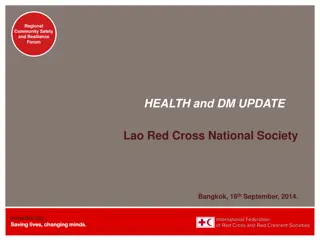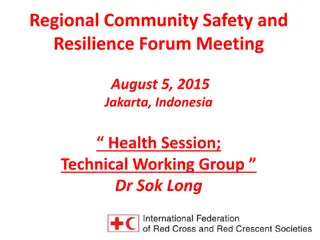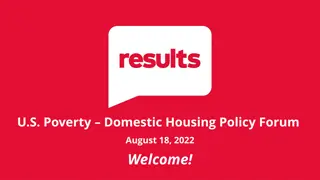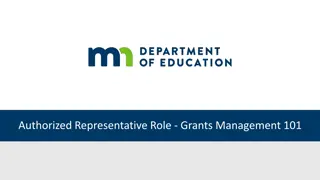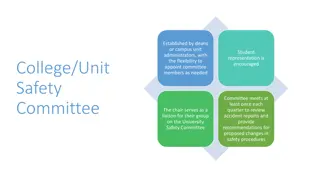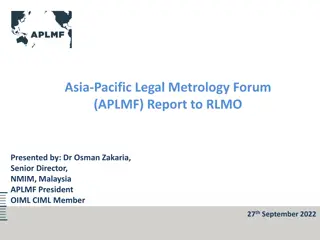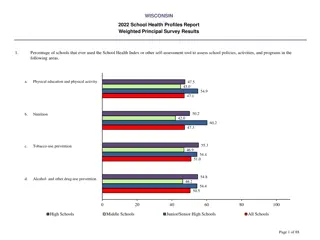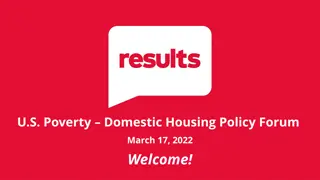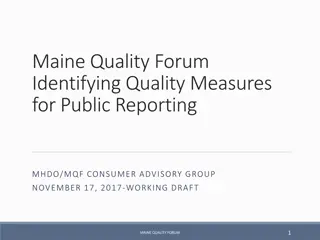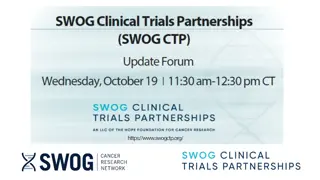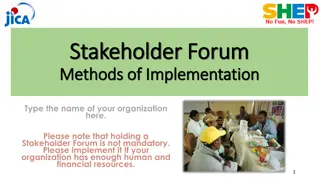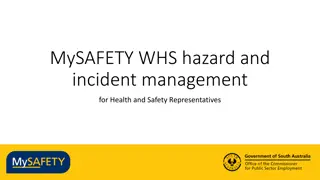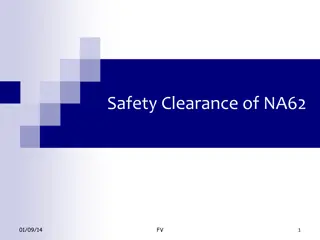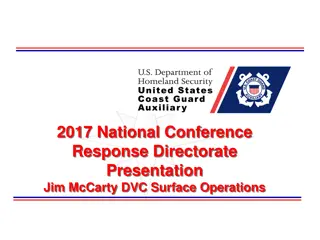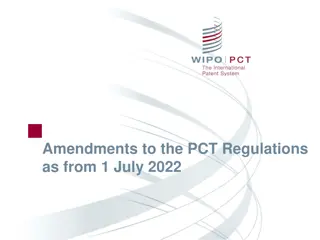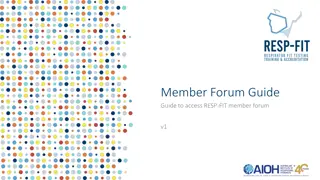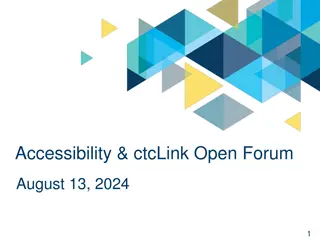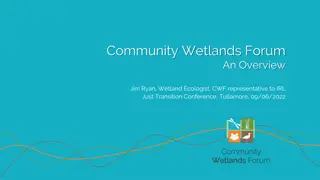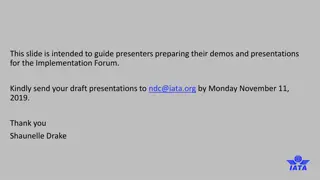Napo Health and Safety Representatives Forum - July 2022 Highlights
The Napo Health and Safety Representatives Forum held in July 2022 addressed various critical issues such as workload pressures, work-related stress, COVID-19 protocols, risk assessments, and more. The session emphasized escalating health and safety concerns, training, stress understanding, and employer policies. Consultation with the workforce, as mandated by the 1977 Safety Representatives and Safety Committees Regulations, was also highlighted.
Download Presentation

Please find below an Image/Link to download the presentation.
The content on the website is provided AS IS for your information and personal use only. It may not be sold, licensed, or shared on other websites without obtaining consent from the author. Download presentation by click this link. If you encounter any issues during the download, it is possible that the publisher has removed the file from their server.
E N D
Presentation Transcript
Napo Health and Safety Representatives forum. 7th July 2022. www.gftu.org.uk
Are you happy for us to record the session so we can share it with colleagues who are unable to be part of the session and refer to it in the future?
Current Health, Safety and Welfare Health, Safety and Welfare concerns? Workload pressures. Work related stress. Pregnancy & parental entitlement. Menopause. Lone working. Homeworking. Covid-19. Ventilation, social distancing etc. Premises issues. Slips trips and falls. Accidents and incidents. Threats and aggressive behaviour. Minibus driving. Legionella and non-potable drinking water. Inadequate or inappropriate PPE. The list is endless!!
A number of dimensions to todays session: Thank you how far can we push things? escalating of Health and Safety concerns. Health and Safety training . Understanding stress and the context for Health and Safety at work. Employer request to all staff regarding acceptance of policies for all sites. Risk assessment practice.
A number of dimensions to todays session: Thank you how far can we push things? escalating of Health and Safety concerns. Health and Safety training . Understanding stress and the context for Health and Safety at work. Employer request to all staff regarding acceptance of policies for all sites. Risk assessment practice.
HSE Website: 1977 Safety Representatives and Safety Committees Regulations. Consulting your workforce in health and safety L146 By law, the employer must consult its workforce about: any change that may substantially affect your workforces health and safety. Such changes may include: new or different procedures types of work equipment premises ways of working (for example, new shift patterns); arrangements for getting competent people to help meet their obligations under health and safety laws, for example, appointing a health and safety manager. information you must give your workforce on the likely risks in their work and precautions they should take. Discuss with employees and representatives the best way for information to be shared. Consider issues of language, literacy and learning disabilities if appropriate. the planning of health and safety training the health and safety consequences of introducing new technology
Escalation of a Health and Safety Concern In your job Within the National Union In your branch Health+Safety rep. Branch secretary. Branch Chair. Your line Manager. Your PDU head. JCC. Napo HQ. National Health and Safety committee(s). Ian Lawrence Katie Lomas Carole Doherty (Probation) Nicola Kenney (CAFCAS) Ian Richards Conference Motion?
The Napo website description of the role of Napo Health and Safety representatives (H&S reps) is; The rights of health and safety reps are laid down in the 1977 Safety Representatives and Safety Committees Regulations, which is part of the Health and Safety at Work Act. Trade Union Health and Safety Representatives have a key role to play in workplace health and safety. They work with employers on health and safety by representing their colleagues health and safety interests. Safety reps are accountable to their branch, and their work, such as around stress, workload and bullying often interlinked with industrial relations issues, so it is important that they work as part of a team with other branch reps. Trade unions appoint H&S reps in recognised workplaces. Health and Safety Representative have the right to: attend meetings of safety committees. investigating the causes of accidents. investigate potential and actual hazards and dangerous occurrences; being consulted by the employer about issues relating to health and safety in the workplace. investigate colleagues complaints. present colleagues concerns to management. carry out workplace inspections; time off with pay as is necessary to carry out those functions and reasonable facilities and assistance; paid time off for training as long as the training is necessary and reasonable ; receive information relevant to any matter that might impact upon health, safety and welfare of the people the safety rep represents. inspecting documents relevant to safety in the workplace. making representations to the employer. receiving information from HSE (Health and Safety Executive ) inspectors, and representing members interest in meetings with HSE inspectors. receiving information from the employer. to be consulted on the planning and organising of any health and safety training. In some respects, Trade Union appointed H&S reps have more right and powers than Trade Union reps in the workplace. The regulations state that no legal duties are placed on safety reps because of their functions and rights which means that a safety rep has no greater liability in law for health and safety breaches than any other employee.
Training: paid time off for training as long as the training is necessary and reasonable ; Facilities time wrapped up in a recognition agreement: time off with pay as is necessary to carry out those functions and reasonable facilities and assistance; Sharing information and being consulted with: to be consulted on the planning and organising of any health and safety training. being consulted by the employer about issues relating to health and safety in the workplace. inspecting documents relevant to safety in the workplace. receiving information from the employer. receiving information from HSE (Health and Safety Executive ) inspectors, and representing members interest in meetings with HSE inspectors. receive information relevant to any matter that might impact upon health, safety and welfare of the people the safety rep represents. Undertaking your Health and Safety function: attend meetings of safety committees. Investigating and reporting on Health and Safety matters: carry out workplace inspections; investigating the causes of accidents. investigate potential and actual hazards and dangerous occurrences; investigate colleagues complaints. present colleagues concerns to management. making representations to the employer.
Training: What Health and Safety training have you done so far? What training do you think that we should do? Facilities time wrapped up in a recognition agreement: Do you have sufficient facilities time to do your Union duties? Have you got a copy of the recognition agreement? What extras does / should it include? Sharing information and being consulted with: Do you feel that you are Done to rather that Done with ? Do you receive relative information (minutes, reports, data etc) ahead of the meetings you are expected to attend? Do you feel involved and valued by the Management and the PDU for your Health and Safety role? Undertaking your Health and Safety function: Are there any barriers to you being a Napo Health and Safety rep? Investigating Health and Safety matters: Do you have the necessary: Skills? Support? Capacity? Resources? To investigate concerns, near misses, accidents and incidents, etc.
A number of dimensions to todays session: Thank you how far can we push things? escalating of Health and Safety concerns. Health and Safety training . Understanding stress and the context for Health and Safety at work. Employer request to all staff regarding acceptance of policies for all sites. Risk assessment practice.
Occupation duties: Duty Criteria for measuring performance KSBs Duty 1 Carry out risk assessments on service users who pose higher levels of risk with complex needs, including sex offenders, domestic abuse perpetrators, individuals who resort to violence and extremist activities. Adherence to legislative requirements K1 K4 K7 K8 K10 K13 S15 S20 B1 B2 B7 Compliance with employer policies and procedures Adherence to legislative requirements Duty 2 Develop Sentence and Risk Management Plans that promote positive change K1 K6 K7 K8 K9 K10 K13 S2 S5 S6 S7 B1 B2 B5 Compliance with employer policies and procedures
Training Assessment Method 2: Case Study and Presentation. Distinction Knowledge: K4 K7 K8 K9 Skills: S1 S3 S5 S20 Behaviours: B The development of: Risk Assessment and Management K = Knowledge S = Skills B = Behaviour Explains how to apply risk assessment, management approaches and associated tools to own roles and responsibilities. Articulates how they have considered principles of professional judgement, including conscious and unconscious bias and maintaining professional boundaries in order to support effective practice. Explains key concepts and theories that underpin their work and how they have integrated these into their practice. Describes how to utilise and evaluate the resources and opportunities available to enhance risk management plans whilst also considering the service users motivation/circumstances. Provides examples of their approach to managing service user risk and their considerations to protecting victims, safeguarding others and promoting positive change. Explains how to gather and utilise relevant sources of information and/or interventions, to analyse, verify and share appropriately for developing robust assessment reports and rehabilitation. Explains the characteristics of domestic violence and sexual Evaluates the approaches of risk assessment and management, drawing on the latest research and developments in practice Explains the process to take when presented with contradictary or limited information and evaluate the opportunities available to aid in their assessment and management of service users. Evaluates effective risk management techniques and how these have been applied in a complex case, referencing research and the impact of risk on the wider community When there was the Apprenticeship Pathway to becoming a Probation Officer Retired 30th November 2021.
Vocational training aspects and ongoing CPD. Health and Safety. Covid 19. Workstation, DSE and MSD s. Risk assessment. First Aid. Fire marshal. Manual handling. Minibus driving (?). Plus any other Continuing Professional Development (CPD) to: Remain qualified and competent. Grow in your role / career. Being a Health and Safety champion Staying interested. Making a difference.
Professional Qualification in Probation - PQiP Health and Safety elements during PQiP. Health and Safety elements in workplace Inductions. Critically reflective practice considering near-misses, accidents and incidents. Developing and sharing good practice. Being competent
A number of dimensions to todays session: Thank you how far can we push things? escalating of Health and Safety concerns. Health and Safety training . Understanding stress and the context for Health and Safety at work. Employer request to all staff regarding acceptance of policies for all sites. Risk assessment practice.
Stress in our work. Occupational stress is a significant problem for Napo members. What to do if you are suffering from stress: Firstly, request a stress risk assessment (please note your Napo safety rep is entitled to be involved in the assessment process). If the problems at work that are causing you stress are affecting your colleagues also then ask your line manager for a team stress risk assessment. Another way to highlight collective issues around stress is to ask colleagues to complete the Napo stress questionnaire. Meet with your employer to discuss the problems shown by the survey results to cause high stress levels - and to agree suitable ways of addressing these issues. Another way to highlight stress problems to the employer, is to complete a Napo foreseeability notice. Use this notice if you are suffering from stress at work and have already notified your line manager - but nothing has been done. Or if you have notified them, but there has been no improvement.
A number of dimensions to todays session: Thank you how far can we push things? escalating of Health and Safety concerns. Health and Safety training . Understanding stress and the context for Health and Safety at work. Employer request to all staff regarding acceptance of policies for all sites. Risk assessment practice.
Employer request: H and S statement of understanding H and S statement of understanding All staff are expected to familiarise themselves with building safety information, processes and control measures. In signing and returning this document, you are agreeing that you have both read and understood all current health and safety generic risk assessments (GRA), safe working practice document(s) and will ensure you access the most recent version prior to entering the building each week.
UNION SAFETY CHECK-UP How many safety reps are there? Are they trained? Has the employer been notified about new reps? Does each rep have a clear constituency? Are there union-side meetings to discuss safety issues? Are all workers covered by a safety rep? Have reps got adequate support and time off? Does the union branch communicate with safety reps and vice versa? Are any groups within the workplace being overlooked shiftworkers or migrant workers for example? Could you negotiate new rights like roving reps or union notices to improve union organisation and effectiveness? Is the safety committee functioning properly so problems raised get remedied and there is effective monitoring of progress? Are health and safety issues considered when bargaining issues such as reorganisations are discussed? If there s problems with any of the above, what are you going to do about it and when? When did you last do a walk through the workplace? When did you last do a formal inspection or investigation? How do you communicate information to members? How do members communicate with you? Are you tackling the right issues? When did you last involve members in a union safety activity a survey, risk mapping or body mapping? Is your training up to scratch? Does management resolve safety problems you identify, or do they stay in the to do pile? Are the top safety priorities the least likely to be addressed? Are you receiving all the documentation you need including copies of risk assessments and workplace accident and sickness records? Do all safety reps receive a copy of Hazards magazine? If there s problems with any of the above, what are you going to do about it and when? GETTING THINGS DONE Be organised Put things in writing Make regular reports Encourage members to raise problems Use agreed procedures Use safety committees Make health and safety agreements with the employer Ensure any partnerships with the employer are genuine and effective Negotiate use of Union Inspection Notices (UINs) Use the law Be clear about your employer s duties and your legal rights Get involved in risk assessments Use inspectors where appropriate Use union power Good communication Surveys, bodymapping, inspections Planning action and reporting back.
A number of dimensions to todays session: Thank you how far can we push things? escalating of Health and Safety concerns. Health and Safety training . Understanding stress and the context for Health and Safety at work. Employer request to all staff regarding acceptance of policies for all sites. Risk assessment practice.
Health and Safety risk assessments. A hazard and a risk are different. An assessment of a hazard or a risk can happen at any time: before, during or after a near miss, incident or accident. No blame, just a learning opportunity. Conscious action is better than unwitting catastrophe! Being safe is in everybody s interest!
Sources of useful information on Health, Safety and Welfare NAPO website and networks including this one. Employers intranet and website. HSE Website and e-bulletins. TUC Website and e-bulletins. Hazards magazine. Emplaw newsletter. How should we develop the Forums to become a more effective community of practice?
How many safety reps are there? Are they trained? Has the employer been notified about new reps? Does each rep have a clear constituency? Are there union-side meetings to discuss safety issues? Are all workers covered by a safety rep? Have reps got adequate support and time off? Does the union branch communicate with safety reps and vice versa? Are any groups within the workplace being overlooked shiftworkers or migrant workers for example? Could you negotiate new rights like roving reps or union notices to improve union organisation and effectiveness? Is the safety committee functioning properly so problems raised get remedied and there is effective monitoring of progress? Are health and safety issues considered when bargaining issues such as reorganisations are discussed? If there s problems with any of the above, what are you going to do about it and when? When did you last do a walk through the workplace? When did you last do a formal inspection or investigation? How do you communicate information to members? How do members communicate with you? Are you tackling the right issues? When did you last involve members in a union safety activity a survey, risk mapping or body mapping? Is your training up to scratch? Does management resolve safety problems you identify, or do they stay in the to do pile? Are the top safety priorities the least likely to be addressed? Are you receiving all the documentation you need including copies of risk assessments and workplace accident and sickness records? Do all safety reps receive a copy of Hazards magazine? If there s problems with any of the above, what are you going to do about it and when? Be organised Put things in writing Make regular reports Encourage members to raise problems Use agreed procedures Use safety committees Make health and safety agreements with the employer Ensure any partnerships with the employer are genuine and effective Negotiate use of Union Inspection Notices (UINs) Use the law Be clear about your employer s duties and your legal rights Get involved in risk assessments Use inspectors where appropriate Use union power Good communication Surveys, bodymapping, inspections Planning action and reporting back.
Ian Richards Ian Richards GFTU Operations Manager Phone: 01509 412167 or 07903 523746 E-mail: ianr@gftu.org.uk





